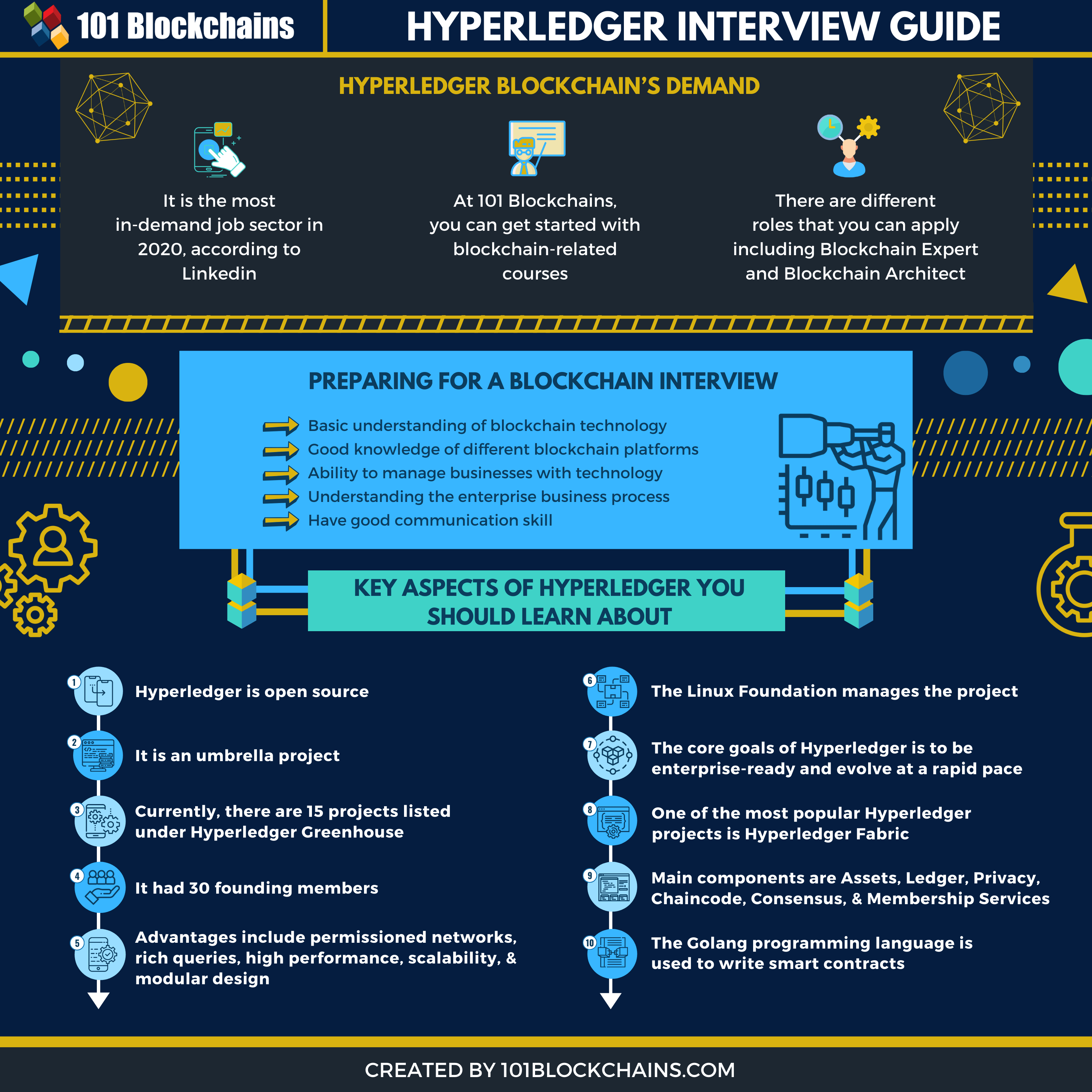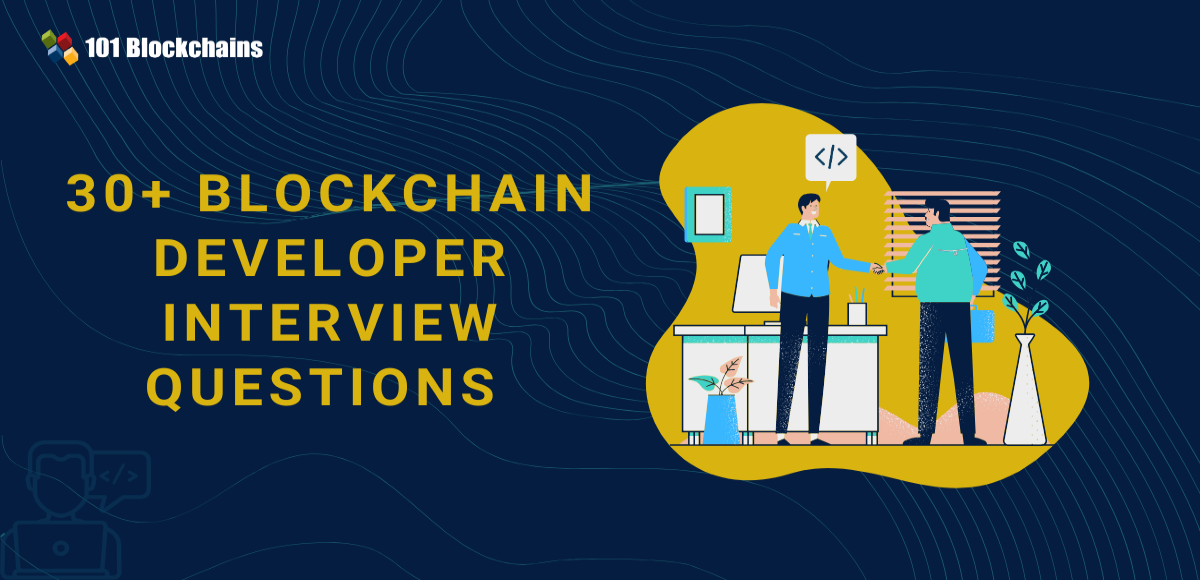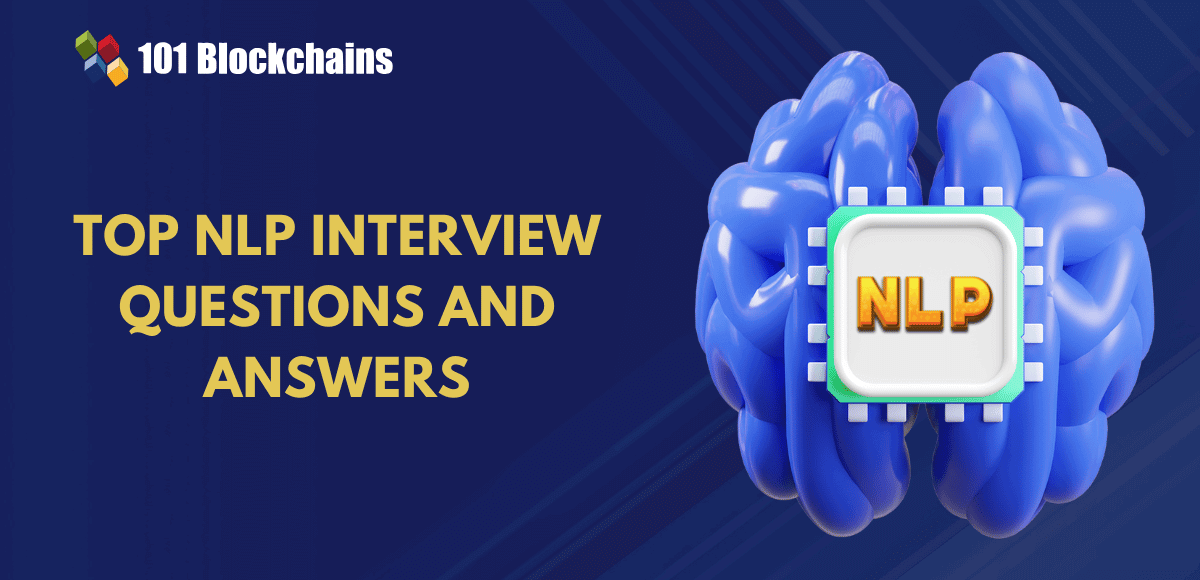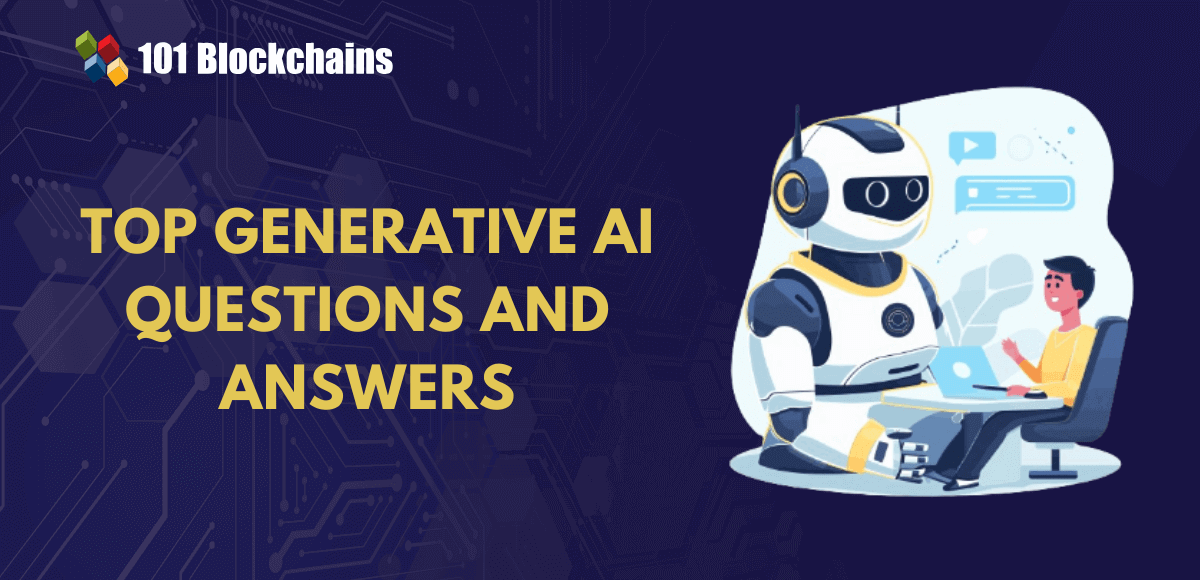Learn how blockchain truly works, master key definitions, and uncover what makes smart contracts so "smart." Dive into the fundamentals, gain valuable insights, and start your blockchain journey today!
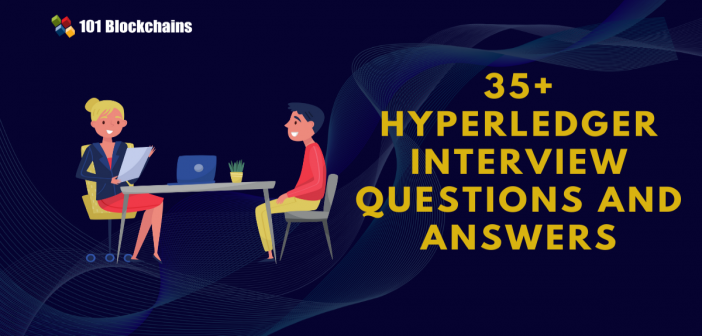
- Interview Preparation
101 Blockchains
- on March 24, 2021
35+ Hyperledger Interview Questions And Answers
Are you preparing for your Hyperledger interview? Here’s a quick guide to the top Hyperledger interview questions and answers to help you prepare for the interview.
Hyperledger has grown in demand over the last couple of years. Its demand is coupled with the blockchain demand for talent. Big companies, including Facebook, Twitter, Microsoft, and others, know the importance of talent and when it comes to new technologies such as Blockchain.
Right now, one of the biggest hurdles for the industries is to work towards a standard for the Blockchain.
Hyperledger blockchain, an umbrella project run by The Linux Foundation, aims to do just that. It is an open-source blockchain technology that aims to advance blockchain adoption through global collaboration.
It has been adopted in many real-world projects, and there are benefits for organizations to stick to an ecosystem that is evolving at a rapid pace. Currently, there are hundreds of members that are currently part of the Hyperledger ecosystem, including the likes of IBM, AirBus, Accenture, and others.
Want to learn the basic and advanced concepts of Blockchain and Hyperledger Fabric? Enroll Now: Getting Started with Hyperledger Fabric Course
How to Prepare for The Hyperledger Interview
Before we go through the top Hyperledger interview questions, we need to learn how to prepare for the interview. As a learner, you should always start from the fundamentals and become strong at it. By doing so, you are opening yourself up to more advanced concepts.
Apart from that, you should get cross-discipline broad skills, a basic understanding of different blockchain platforms, the ability to manage the business with technology, an understanding of the enterprise business process, and much more!
These points also apply to you for Hyperledger Interview as it is based on Blockchain. All you need to do is use the points according to a company that is trying to hire you for Hyperledger. Anyway, the interview should help, and that’s why you should give it a read before proceeding below.
Build your identity as a certified blockchain expert with 101 Blockchains’ Blockchain Certifications designed to provide enhanced career prospects.
Blockchain and Hyperledger Demand
There is no doubt that Blockchain is in demand. After all, it is changing how our industries work and function. It’s the ability to solve problems that were thought to be impossible earlier that makes it so amazing! Moreover, you will find a lot of certification programs around Blockchain.
Please include attribution to 101blockchains.com with this graphic. <a href='https://101blockchains.com/blockchain-infographics/'> <img src='https://101blockchains.com/wp-content/uploads/2020/03/HYPERLEDGER_INTERVIEW.png' alt='hyperledger interview='0' /> </a>
Linux’s Foundation’s Hyperledger is a great attempt to provide tools to use Blockchain effectively. In fact, many top schools, including the likes of MIT and Berkey, are already engaging their students by providing cryptocurrency and blockchain classes.
Overall, we can see a huge demand in both Blockchain and Hyperledger in the general space. CNBC also reports that Blockchain is a top skill according to Linkedin in 2020.
Overall, it is easy to say that you have chosen the right path if you are trying to get into the industry.
Skills Required
As you can see, there are tons of demands for Hyperledger. It is easy to say that you will get a job if you have the skills and the aptitude to clear the interview. Most of the time, it is the inability of the candidate to know the job requirements before trying to get it.
Apart from getting a job through the top Hyperledger interview questions, we want to go through the skills required to become a blockchain specialist and blockchain architect.
-
Blockchain Professional
A blockchain professional is someone who has the skills to develop blockchain-based solutions. He/she has skills such as technical conscience, programming language expert, design and develops blockchain solution, configures blockchain infrastructure, and so on! Make sure to go through the required skills to ace all the Hyperledger interview questions.
-
Blockchain Architect
A blockchain architect has a different role to play altogether. He/she is the person who designs the blockchain solution for an enterprise or an organization. More so, an architect will work closely with R&D teams to make it happen! The key skills a blockchain architect should have include blockchain fundamentals, leadership skills, data structure knowledge, cryptocurrency proficiency, and so on! Understanding the difference between each position can help you present your skills accordingly and adjust them in your Hyperledger interview.
Aspiring to become a certified blockchain architect? Enroll Now in Certified Enterprise Blockchain Architect (CEBA) Program
Top 35+ Hyperledger Interview Questions
Best Hyperledger Interview Questions: Basic Level
1. What Is Hyperledger?
Answer: Hyperledger is an umbrella open-source collaboration project managed by The Linux Foundation. It offers a Hyperledger Greenhouse ecosystem, which consists of many projects ranging from tools, frameworks, and libraries.
As it is open-source, it is actively developed, and hundreds of developers all across the world work together to improve it. It was introduced in Feb 2016 in the beautiful city of San Francisco, California. At that moment, it has 30 founding members, including IBM, VMWare, SWIFT, R3, and others.
2. What Are the Core Goals of Hyperledger?
Answer: The core goals of Hyperledger are as below.
- Create codebases and distributed ledger technology that is enterprise-grade and open source. These should help support business transactions.
- Build technical communities so that they can work towards building and developing shared ledger POCs, Blockchain, field trials, and much more!
- Educate the public about the blockchain technology market opportunity.
- Go for a community-driven architecture that is open and neutral. It should be supported by business and technical governance.
- Lastly, they want to promote the community so that it can reach as many frameworks and platforms.
Take a deep dive into common hyper ledger terms with the Hyperledger Flashcards
3. What Projects Are Listed Among the Hyperledger Umbrella?
Answer: Currently, there are 15 Hyperledger projects under the Hyperledger Greenhouse. They are as below.
- Hyperledger Aries
- Hyperledger Avalon
- Hyperledger Besu
- Hyperledger Burrow
- Hyperledger Caliper
- Hyperledger Explorer
- Hyperledger Fabric
- Hyperledger Grid
- Hyperledger Indy
- Hyperledger Iroha
- Hyperledger Quilt
- Hyperledger Sawtooth
- Hyper ledger Transact
- Hyperledger Ursa
Note: In the Hyperledger interview questions, the interviewer expects you to know all the projects. However, if you are not able to answer all, then do not worry, as the interviewer will focus on your technical knowledge as well.
4. What Is Hyperledger Fabric?
Answer: Hyperledger Fabric is a popular Hyperledger project. It is used for developing solutions and applications with a modular architecture. Some of its key features include plug-and-play membership, consensus, and other features.
This gives the industry a lot of options to work with blockchain technology and can be used in a plethora of industry use cases. Also, its focus is to bring more scalability without the need to sacrifice privacy. Currently, Hyperledger Fabric 2.0 is out.
5. What Is Hyperledger Explorer?
Answer: Hyperledger Explorer is a part of the Hyperledger Umbrella projects. It lets developers create a web application to view/query blocks, associated data, and transactions in Hyperledger. It also enables you to check transaction families and any other information that is available in the ledger.
6. What Is Hyperledger Aries?
Answer: Hyperledger Aries facilitates an interoperable, reusable, and shared toolkit aimed at digital credentials. It lets you design the solutions and initiatives of transmitting, creating, and storing verifiable digital credentials. Therefore, it is a library and works in conjunction with Hyperledger Ursa’s cryptographic support. It is best suited for peer-to-peer network interactions in a blockchain environment.
7. What Is Hyperledger Avalon?
Answer: Hyperledger Avalon is a tool that is an independent ledger implementation using the Trusted Compute Specifications. The Enterprise Ethereum Alliance publishes it. With it, the blockchain processing can be securely moved to the dedicated computing resources from the main chain.
8. What Is Hyperledger Besu?
Answer: Hyperledger Besu is an enterprise-ready Ethereum client. It can be both private and publicly permissioned. It comes with many consensus algorithm support, including PoA, PoW, and others.
9. What Is Hyperledger Burrow?
Answer: Hyperledger Burrow is a distributed ledger software that focuses on speed, developer ergonomics, and simplicity. It can also be defined as a complete single-binary blockchain distribution. More so, it comes with the support for both WASM and EVM-based smart contracts. It also has permissioning and governance in-built and can also do on-chain proposal transactions.
10. What Is Hyperledger Sawtooth?
Answer: Hyperledger Sawtooth is a distributed ledger software that offers a modular and flexible architecture, just like Fabric. It enables enterprises to distinguish the core system from its application domain. This means that smart contracts can be configured without the need to know the core system design. It also supports different consensus algorithms, including Proof of Elapsed time (PoET) and Practical Byzantine Fault Tolerance (PBFT). Here’s a guide to Hyperledger Sawtooth Vs. Fabric that will compare these two and point out the differences.
11. What Is Hyperledger Cello?
Answer: It is another tool in the Hyperledger Greenhouse. It offers a blockchain operational dashboard. It improves the managing, creating, and using blockchains. Again, it also lets enterprises create Blockchain as a Service. Lastly, it can be used as an operational console, letting you manage enterprise blockchain efficiently. It can run on different infrastructures, including virtual machines, bare metal, and other container platforms.
Start your blockchain journey Now with the Enterprise Blockchains Fundamentals
12. What Is Hyperledger Transact?
Answer: Hyperledger Transact is a library that reduces the distributed ledger software writing development. It provides the ability also to create a standard interface that lets execute smart contracts.
13. What Is Hyperledger Caliper?
Answer: Hyperledger Caliper is a tool within the Hyperledger ecosystem. With it, you can benchmark Blockchain, its performance using the predefined use-cases. It generates reports and also gives the user references to other blockchain solutions, including Hyperledger Sawtooth, Ethereum, Hyperledger Besu, Hyperledger Burrow, FISCO BCOS, Hyperledger Fabric, and Hyperledger Iroha.
14. What Is Hyperledger Iroha?
Answer: Hyperledger Iroha is yet another distributed ledger software that works well with IoT and infrastructural projects. It can easily be integrated with them, and it is also simple to use. Its key features include modular, simple construction, C++ design, and other fault-tolerant consensus algorithms.
15. What Is Hyperledger Quilt?
Answer: Hyperledger Quilt is an Interledger blockchain protocol Java implementation. It enables crypto and fiat payments across any payment network.
16. What Is Hyperledger Grid?
Answer: Hyperledger Grid is a supply-chain-centric reference implementation solution. It is domain-specific and hence will work with a supply chain-based business. With it, businesses can reference the implementation of data models, data types, smart contracts, and so on! It also follows open standards and industry best practices. So, that’s why it’s a great platform for use in supply chain industries.
Curious to learn about blockchain implementation and strategy for managing your blockchain projects? Enroll Now in Blockchain Technology – Implementation And Strategy Course!
17. What Is Hyperledger Indy?
Answer: Hyperledger Indy is a distributed ledger software that offers reusable components, tools, and libraries for digital identities on distributed ledgers and blockchains. It is also interoperable and works with different blockchains.
Best Hyperledger Interview Questions: Medium Difficulty
18. Tell Us the Advantage of Hyperledger Fabric?
Answer: There are many benefits of Hyperledger Fabric in an enterprise environment.
- Permissioned networks: With Hyperledger Fabric, it will be possible for any enterprise or organization to create a fully permissioned Blockchain. This means that the organizations can decide who and what anyone can access the network. The identities need to first do a KYC before they can access any network resources. It helps organizations that rely heavily on data security, including financial sectors, health care, and banking.
- Scalability and performance: Hyperledger offers performance and scalability with its Hyperledger projects. Hyperledger Fabric, for instance, offers the ability to use a modular design, which improves scalability without sacrificing the privacy of the network. It is also a great level of trust.
- Rich Queries: The Hyperledger fabric offers state transitions in a sequenced manner. This gives the platform the ability to generate key-value pairs.
- Modular design: Fabric offers a modular design, which in turn makes it easy for enterprises to integrate it into their system. It also opens up a lot of use-cases in the industry that can utilize modular design.
- Chaincode functionality: Another benefit of Hyperledger Fabric includes using the chaincode applications, which in turn ensure that transactions with transfer ownership are subjected to the same requirements and rules.
19. What Are the Components of Hyperledger Fabric?
Answer: It has two components, including State data and transaction log.
20. Tell Us the Difference Between Ethereum And Hyperledger?
Answer: There are many differences between Ethereum and Hyperledger. At the core, Hyperledger and Ethereum have different purposes. For instance, Hyperledger is for a B2B business, whereas Ethereum is for generalized applications and B2C businesses. Both Hyperledger and Ethereum offer private and permissioned networks. However, Ethereum gives the option to create public blockchain networks as well.
Ethereum utilizes the PoW algorithm consensus, which requires mining, whereas Hyperledger offers a pluggable consensus where mining is not required. The last difference is that it utilizes the Golang programming language, whereas Ethereum utilizes Solidity.
Excited to build your skill in Ethereum development by leveraging the ethers.js library? Enroll Now in Ethers.Js Blockchain Developer Course!
21. What Is the Genesis Block?
Answer: Genesis block is the first block that is generated in a blockchain platform. It is also the first Blockchain that is generated in Hyperledger distributed blockchain ledger. The transactions that are generated later on are added to the later blocks with proper verification.
22. What Are the Nodes in Hyperledger Fabric?
Answer: The communication entries in Hyperledger are known as nodes.
23. What Is A Channel in Hyperledger Fabric?
Answer: The subnet of a Hyperledger network is known as the channel. There can be as many channels as possible in the blockchain network.
24. Are Smart Contracts and Chain Codes Similar?
Answer: They are the same in reality.
25. What Is the Consensus Mechanism?
Answer: A consensus mechanism is used to verify the transactions and other activities within the blockchain network. There are many popular consensus algorithms, including Proof-of-Work (PoW) and Proof-of-Stake (PoS). Hyperledger utilizes the PBFT model (Practical Byzantine Fault Tolerance).
Best Hyperledger Interview Questions: Expert Level
26. What Are the Main Components of The Hyperledger Fabric Model? Describe Them Shortly.
Answer: At the core, Hyperledger Fabric wants to provide a customized yet powerful and comprehensive enterprise blockchain solution. The Hyperledger Fabric Model consists of six key design features.
- Assets: The assets are used to define items that offer value and can be exchanged over the network. It can be food, medicine, or cryptocurrency.
- Ledger Features: Ledger offers a plethora of features, including the ability to encode the transaction history of each channel. It is also immutable and shared. It supports a SQL-like query.
- Privacy: The privacy feature ensures both private and channel data collections.
- Chaincode: Chaincode is at the core of Fabric. It ensures multiple aspects, including performance, scalability, across node types, verification, and trust.
- Consensus: It handles the network consensus with scalability and security.
- Security & Membership services: Offer the ability to create permissioned networks
Note: This is another one of the most popular interview questions for Hyperledger.
27. What Is the Technical Steering Committee (TSC)?
Answer: The technical steering committee is responsible for steering the values and responsibility of the Hyperledger technical direction. The committee comprises 11 elected members. They have a complex range of responsibilities, which are defined in the Hyperledger Charter.
28. What Are the Three Stages A Hyperledger Project Goes Through?
Answer: The Hyperledger project cycle can consist of five possible states
- Proposal: Here, TSC receives the project proposals.
- Incubation: The project, once approved by TSC, enters Incubation
- Active: Any project that has exited the Incubation is set to Active.
- First Major Release: This is when the project goes through its first major release.
- Deprecated: In this stage, the project is not actively developed. It is developed and maintained by its community for six months. After that, no formal releases are done.
- End of Life: The project is neither maintained nor developed.
Note: Telling the interviewer about the five possible states implies that you know how the projects are maintained. This is one of the most popular interview questions for Hyperledger.
29. What Is A YAML File?
Answer: YAML file is a data-serialization human-readable language. It is used in the Hyperledger project. It is used to configure different aspects of the project and blockchain applications.
30. In Which Language Chaincode Is Written In?
Answer: Chaincode is written using multiple languages, including Java and GO.
31. What Is Golang?
Answer: Golangis a programming language that is used in the Fabric project. It is used to write smart contracts, and also, the chain code is written using it.
32. Tell Us About the Different Types of Nodes in Hyperledger Fabric?
Answer: There are three types of nodes in Fabric.
- Peer node
- Client node
- Order node
Each node has its own functionality. For instance, the peer needs to commit the transaction that is initiated by the client node. The guarantee of the transaction completion is taken care of by the order node.
33. What Does Baas Mean?
Answer: BaaS stands for Blockchain as a Service — which is provided by top-tier companies including Microsoft, Google, etc. to provide Blockchain as a complete service. This way, the enterprise doesn’t have to build its own blockchain solution and can host its blockchain application on the serviceable Blockchain.’
Want to know more about BaaS? Enroll Now: Getting Started with AWS Blockchain as a Service (BaaS)
34. List Out Some of The Hyperledger Fabric Use Cases
Answer: There are multiple Hyperledger fabric use cases. Here are some of them –
- Food safety
- Supply Chain management
- Security for IoT devices
- Automated insurance claim and audits
- Increased liquidity in real-estate
35. Can the Orderers Within the Hyperledger Network See the Transaction Data?
Answer: No, the orderers don’t have access to open the transactions. They can only order the transactions. You can also avoid the orderers by using the private data feature available within the network. On the other hand, you can also encrypt or hash the data before calling the chaincode.
36. Describe the Process of Querying Historical Data for The Sake of Data Provenance?
Answer: You have to use the chaincode API GetHistoryForKey(). This will return the value for any given key.
Conclusion
This leads us to the end of the most popular interview questions for Hyperledger. Hyperledger is working on a variety of open-source blockchain projects, and many enterprises are more than interested in using those platforms.
Therefore, it’s quite common for enterprise companies to ask questions related to Hyperledger and test out whether you are capable of handling the technical responsibilities of their projects. These questions for the Hyperledger interview will help you focus on the core concepts of the tech. However, you have to remember that without getting your basics right, you can’t expect to answer all of their questions. So, make sure to learn about Hyperledger architecture as much as you can.
*Disclaimer: The article should not be taken as, and is not intended to provide any investment advice. Claims made in this article do not constitute investment advice and should not be taken as such. 101 Blockchains shall not be responsible for any loss sustained by any person who relies on this article. Do your own research!

